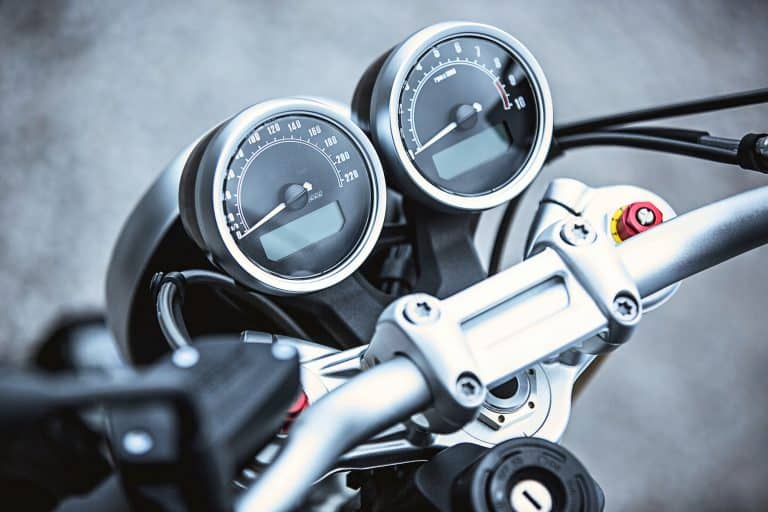As a motorcycle rider, you know that motorcycles rev high. But why do they rev so high? There are many reasons for this. This blog post will discuss five of the most common reasons that go into increasing the engine speed on a motorcycle to what is called “redline.”
Motorcycles Rev high because is because their lack of torque. Because motorcycles have little torque, they must have high-revving engines in order to generate adequate power. Your motorcycle’s torque is closely linked to the RPMs of your engine.
Let’s explore some of the key reasons why motorcycles rev high.
High RPM = More Torque
As mentioned above, motorcycles rev high because they lack torque. Torque is the rotational equivalent to horsepower in that it deals with how much power can be applied at a certain speed or RPMs. The higher your engine’s RPMs are, the more torque you will have and thus creating greater acceleration and performance from your motorcycle engine. This means having to shift less often when riding up hills or mountains where shifting gears would be necessary if you had a lower-revving bike instead of one that has several thousand RPMs under its belt.
Power/Weight Ratio of a Motorcycle
Motorcycles Rev High because of their lightweight and higher horsepower than cars. The power-weight ratio for cars is about 20 hp/ton while it is 30hp/ton for bikes. Vehicles with low ratios tend to have smaller engines which means lower torque but this isn’t necessarily true in all cases since some vehicles also use bigger air intakes, exhaust systems, etc., thus increasing the amount of air coming into the engine.
Higher RPM = More Accelleration
We all know that motorcyclists love acceleration and speed.
Another reason motorcycles rev so high is to increase acceleration. When your motorcycle picks up speed, there are two ways for you to go faster; either change gears or let on the gas and allow the engine to climb higher in RPMs where it will be operating more efficiently (and thus increasing your rate of acceleration). This second option can lead into a “power band” which essentially means that by letting your bike’s RPMs climb naturally, you’ll reach optimal power output at around 6000RPM’s while if you were to shift gears instead, this would happen closer to 8000RPMs.
A Higher Ranger of RPMs Helps you Manuever
Another reason motorcycles rev so high is because controlling them requires finesse rather than brute strength like cars does. If you’ve ever driven an automatic car, you know that there is little to no finesse involved. You simply step on the gas and drive. But with motorcycles, it’s not so simple. If you want your bike to accelerate quickly or go faster than another rider, then revving the engine higher can help provide better acceleration as well as more speed which also requires twisting your throttle more aggressively (and thus increasing RPMs).
Now that we’ve explored some key reasons why motorcycles rev so high, let’s go over some common questions that I was curious about when researching motorcycle RPMs, torque, and revving.
What can the Average Motorcycle Rev to Before Redlining?
On average they can rev to about 8000 RPM before they reach redline.
It’s important to note that different bikes and exhaust setups will change the exact number of peak RPM points, but on most bikes, they’ll max out around 8,000 rpm. Some motorcycles can outperform others with a mechanical drive (without the use of an electric starter) such as Harley Davidson’s Twin Cam 103 engine which has 12,000 peak revolutions per minute at redline.
Can I increase my Motorcycle RPM?
Yes! Increasing your motorcycle’s torque and horsepower will cause the engine to spin faster and increase your motorcycle’s RPM.
Higher performance motorcycles will generally have a higher redline than lower-end bikes, but both can be tweaked to get more power out of them. Here are some things you can do:
Upgrade Carburetor
Upgrade the carburetor or replace it altogether with a different option such as an air intake or fuel injection system that enables more air into the combustion chamber; this increases how much fuel is mixed with oxygen which in turn results in an increase in energy and delivers an increased amount of KEN (power) at redline.
Performance Exhaust System
Invest in a performance exhaust system to increase airflow and reduce backpressure, resulting in more power at redline with improved throttle response (fuel injection systems require less RPM than carburetors).
Improve Handling
Whist this one won’t technically improve your RPMs it will improve your performance hugely which in turn will improve your torque! Improve your motorcycle’s handling using risers or footpegs for tightening upturns and assuring that your motorcycle can handle the increased torque.
What should my RPM be Idle at?
A motorcycle’s RPM should be around 800 when it is idling. Anything from 600 to 1000 RPM would be considered normal. If your motorcycle is below this you might be in a higher gear than first. And if your motorcycle is revving higher than this at idle than you outside of you should consider taking it to a mechanic.
What will cause my Motorcycle to Decrease in RPMs?
When you’re accelerating your front tire typically loses grip and tries to lift off the ground, though this can vary depending on throttle input and vehicle weight distribution. This loss of traction causes a drop in speed which results in a lower horsepower, torque, and engine rpm; if losses are too great they’ll redline! Although this phenomenon happens frequently at higher speeds (especially with heavy bikes) it also occurs at much lower speeds such as parking or coming up to an intersection from a stoplight.
Can you Convert RPM to MPH?
Yes you can but this one is a little beyond me, check out this article that explains how.






